- 現在位置
- トップ > 白書・統計・出版物 > 白書 > 文部科学白書(英文) > 2018年 文部科学白書(英文) > Special Feature 2: Strengthening Measures for Severe Disasters
Special Feature 2: Strengthening Measures for Severe Disasters
Japan, with its natural conditions, is vulnerable to a variety of natural disasters including earthquakes, tsunami, storms, tornados, heavy rains and volcanic eruptions.
Especially in recent years there have been frequent severe rain storms concentrated in small areas including rain with hourly rainfall exceeding 50mm. Large-scale earthquakes also have occurred frequently. Above all, earthquakes that could cause tremendous human and material damages are predicted to occur with high probability within 30 years from now: 70 to 80% for a Nankai Trough Earthquake and around 70% for Tokyo Inland Earthquake.
In response to many disasters and weather abnormalities in FY2018, including earthquakes, heavy rains and extreme heat, MEXT is promoting restoration of school facilities, support for affected children, safety measures for concrete block fences and installation of air conditioners. In preparation for increasingly severe weather disasters and imminent huge earthquakes, MEXT is also promoting measures for national resilience, improvement of school facilities and disaster prevention education for disaster prevention and mitigation, disaster protection measures for cultural properties and research and development concerning disaster prevention.
Major disasters/weather abnormalities in FY2018 and response by MEXT
Major disasters/weather abnormalities in FY2018
(1) Situation of damage
On June 18, 2018, an earthquake with maximum seismic intensity 6 lower occurred centered in the northern part of Osaka Prefecture. Many railways suspended service during commuting hours causing major disruptions.
This was followed by Heavy Rain in July 2018 mostly in the area from western Japan to Tokai from June 28 to July 8. The record heavy rain caused more than 200 deaths. In addition, typhoons hit Japan one after another and inflicted damages in many parts of the country, which included flooding and the power outage of Kansai International Airport caused by Typhoon 21. On September 6 Hokkaido Eastern Iburi Earthquake with maximum seismic intensity 7 led to a wide-area power blackout across Hokkaido.
The school community also experienced a very painful accident. A concrete block fence of a school collapsed due to the earthquake centered in the northern part of Osaka Prefecture and killed a girl who was on her way to school. The Heavy Rain in July 2018 resulted in casualties among children and caused large-scale flooding.
Because many school facilities were used as shelters, it was difficult for these schools to resume school activities.
As a result, many schools started summer vacation ahead of schedule. Casualties of the Hokkaido Eastern Iburi Earthquake also included school children who were involved in landslides at home. Some schools could not use school buildings due to subsidence, etc. Furthermore, a string of typhoons inflicted damages to roofs, windowpanes and other parts of many school facilities all over the country.
After mid-July, temperature rose significantly in northern, eastern and western Japan. The monthly mean temperature of eastern Japan in July was the highest since records began and caused a very painful accident where a boy became unconscious in classroom after a field trip and later died.
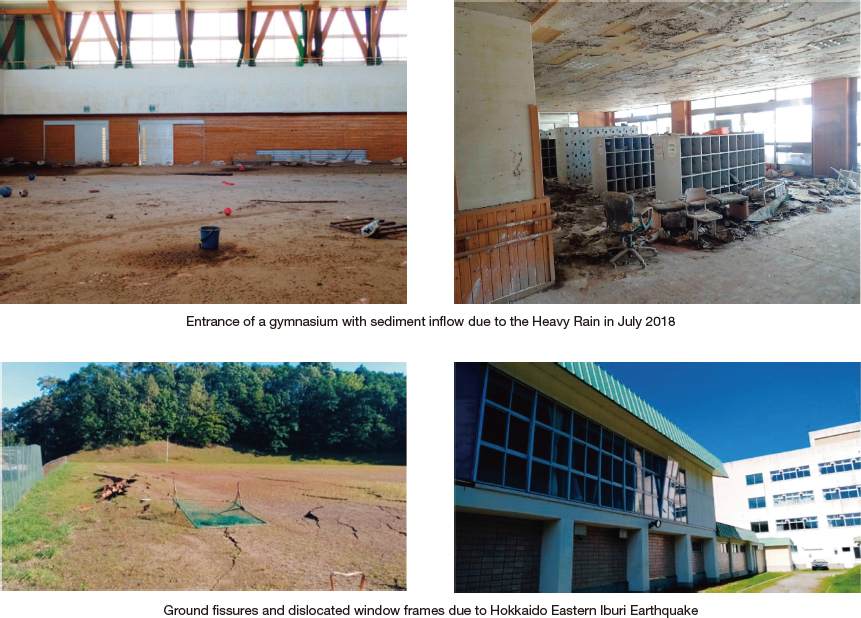
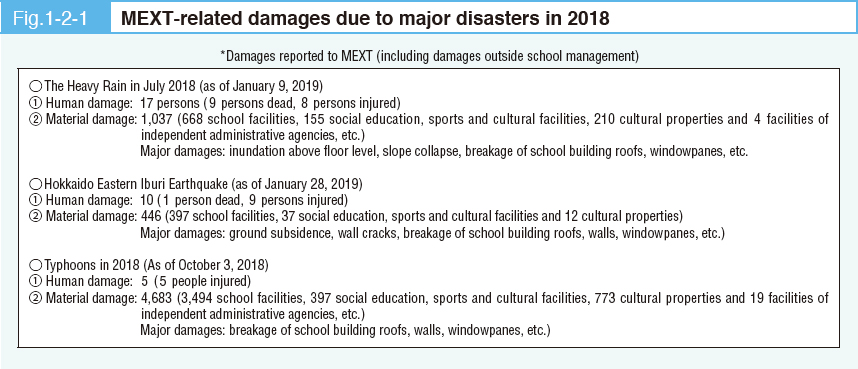
(2) Support for restoration of school facilities, etc.
MEXT provides financial supports for quick restoration of school facilities, etc. Based on the Act on National Treasury’s Sharing of Expenses for Recovery of Public School Facilities Damaged by Disaster and the Act on Special Financial Support to Deal with the Designated Disaster of Extreme Severity so that affected schools can smoothly resume their educational activities. For the school facilities damaged by the disasters in FY2018, the ministry provides support by including the necessary expenses in the first and second supplementary budgets of FY2018 based on the requests from the affected areas and specific damages.
MEXT also provides financial supports for restoration of damaged public school facilities and construction of temporary school buildings when early restoration is difficult. In FY2018, the ministry reduced the burden on affected local governments by expanding the scope of exemption from field survey by MEXT officials and simplifying paperwork. As of the end March 2019, 750 of the 1,107 restoration projects with support from the state were completed.
National subsidy was provided also for restoration of national university facilities. As of the end March 2019, 63 of the 97 restoration projects with support from the state were completed.
Because the Heavy Rain in July 2018 and the Hokkaido Eastern Iburi Earthquake were designated as severe disaster*1, government subsidy was provided also for restoration of private school facilities. In FY2018, paperwork for government subsidy was simplified also for private schools in addition to public schools. As of the end March 2019, 41 of the 81 restoration projects with support from the state were completed.
(3) Mental health care, financial support, etc.
For financial support and mental health care of children affected by the Heavy Rain in July 2018 and the Hokkaido Eastern Iburi Earthquake, MEXT increased the teacher quota and assigned additional school counselors and school support staff.
The ministry asked prefectural boards of education to provide financial support for school attendance and High School Tuition Support Fund, etc. flexibly, and also added financial support for students affected by disasters to government subsidy programs. Furthermore, the ministry included the expenses necessary for supports such as reduction or waiver of university tuition and enrollment fees, etc. in the first and second supplementary budgets of FY2018. Japan Student Services Organization provided emergency scholarship loan and support fund so that affected students would not give up school for an economic reason.
Prevention of collapse of concrete block fences and other safety measures
The earthquake centered in the northern part of Osaka Prefecture on June 18, 2018 caused a very painful accident: a concrete block fence of a school collapsed and killed a girl on her way to school. In response to the accident, on June 19 MEXT asked parties that establish schools across the country to carry out safety inspection of concrete block walls and other facilities. The ministry checked the progress and compiled the results on August 10*2.
The survey revealed that 12,652 schools, or about one fourth of schools nationwide (51,082 schools) have “a concrete block fence, etc. with safety problem based on visual inspection.
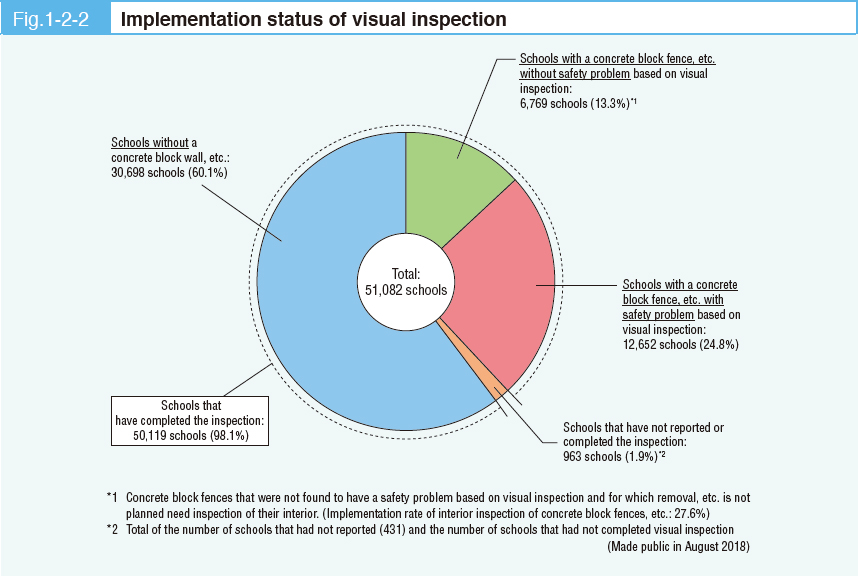
In response to the results, MEXT gave notice to parties that establish schools to take emergency measures including safety inspection and warning to children, and promptly improve the concrete block fences that had been found to have a safety problem.
Based on the survey results, the ministry included 23.2 billion yen in the first supplementary budget of FY2018 for prompt implementation of safety measures for concrete block fences, etc. by the parties that establish schools. With the budget, MEXT created special subsidy for repairing concrete block fences and installing air conditioners.
MEXT will carry out a follow-up survey and other measures to ensure safety of school facilities.
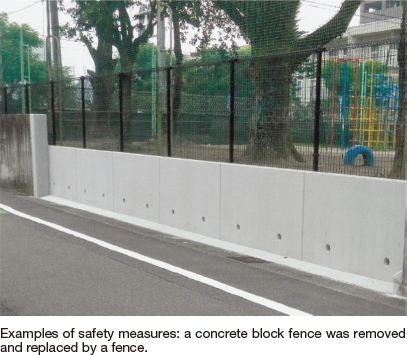
Installation of air conditioners as a heatstroke countermeasure in public elementary and junior-high schools
Since school is a place where children spend most of their day, it is important to secure an appropriate learning environment using an air conditioner according to the local climate.
To secure an appropriate learning environment, MEXT has promoted installation of air conditioners in public elementary and junior-high schools using the subsidy for environmental improvement of school facilities. The air conditioning rate of public elementary and junior-high schools is 49.9% as of September 2018.
In summer 2018, Japan was hit by an almost disastrous heat wave. A very tragic accident occurred in July of the same year: a boy became unconscious in classroom after a field trip and later passed away. In response to the accident, MEXT asked boards of education on July 18 for appropriate responses including safety management and student guidance in consideration of increasing risk of heatstroke. In addition, the ministry created a special subsidy for repairing concrete block fences and installing air conditioners, and included 81.7 billion yen in the first supplementary budget of FY2018 to install air conditioners in public elementary and junior-high schools across the country in order to promptly ensure the safety and health of children in light of the occurrences of health problems caused by such violent heat.
Additional light, heating and water utility costs for operation of the air conditioners will be included in calculation of ordinary tax allocation from 2019.
Reconstruction following the Great East Japan Earthquake*3
Eight years have passed since the Great East Japan Earthquake on March 11, 2011. Human damage of the earthquake among people related to MEXT (infants, children, students, teachers, other personnel, etc.) is: 659 killed, 79 missing and 262 wounded. Material damages to school facilities, social education facilities, cultural properties, etc. exceeded 12,000 cases across the country.
Setting the 10 years up to FY2020 as the reconstruction period and positioning the latter five years from FY2016 to 2020 as the “reconstruction and vitalization period”, the government has been making full-scale efforts for restoration and reconstruction of affected areas.
As a result, reconstruction is steadily progressing in the areas hit by the earthquake and tsunami toward the final stage of the 10-year reconstruction period. Evacuation orders were lifted in the areas affected by the nuclear disaster in Fukushima excluding the difficult-to-return zone”. Movements toward reconstruction and rebuilding of Fukushima have started in earnest.
In this context, future-oriented education free from conventional purposes and methods has been practiced in many places in Tohoku region after the earthquake. Newly opened Fukushima Prefectural Futaba Mirai Gakuen High School graduated its first students in March 2018 and opened its junior-high school in April 2019.
MEXT is working for reconstruction and vitalization while continuing supports for the afflicted areas and people.
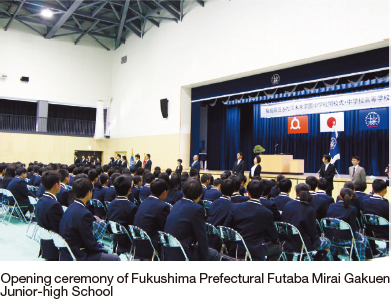
Measures of MEXT pertaining to National Resilience
Review of the Fundamental Plan for National Resilience
With the aim of creating a country and regions resistant to large-scale natural disasters and improve local residents’ ability to protect their lives and livelihood, the Basic Act for National Resilience Contributing to Preventing and Mitigating Disasters for Developing Resilience in the Lives of the Citizenry was promulgated and enforced in 2013 and the Fundamental Plan for National Resilience was decided by the Cabinet in June 2014. On December 14, 2018, a Cabinet Decision was made to review the Fundamental Plan in light of the valuable lessons learned from disasters in recent years and changes in social and economic conditions.
MEXT will implement measures for national resilience in a planned way so that Japan can exert sufficient resilience when a catastrophic disaster caused a national emergency. The measures include: earthquake-resistant measure including nonstructural members of school facilities, etc. that are designated as evacuation shelters; strengthening disaster protection functions by securing generation facilities, hygienic environment, measures to deal with aging deterioration and measures for disaster prevention education; securing of diverse information collection means including seismic, tsunami and volcano observation networks; research and development on measures to deal with aging infrastructure, and; earthquake-resistance and preservation measures for cultural properties.
Three-year emergency measures for National Resilience Contributing to Preventing and Mitigating Disasters
Due to the Heavy Rain in July 2018, Typhoon 21, the Hokkaido Eastern Iburi Earthquake and other natural disasters in recent years, some important infrastructure indispensable for people’s living and the national economy lost functions (e.g. a wide-area power blackout, closure of airport terminal). In response, 12 ministries and agencies carried out emergency inspection to ensure functioning of important infrastructure. Based on the inspection results, the cabinet decided a 7 trillion-yen project, “Three-year emergency measures for National Resilience Contributing to Preventing and Mitigating Disasters” on December 14, 2018 to implement particularly urgent measures in a concentrated manner for three years so that important infrastructure can maintain its functions at the time of natural disaster.
MEXT has decided to carry out 12 emergency measures including improvement of external walls, ceilings, etc. with a risk of falling at the time of disaster and the earthquake resistance of structures of school facilities; strengthening of disaster response of research and development agency facilities and; construction of a new observation network for earthquakes and tsunamis along the Nankai Trough. Based on these emergency measures, the ministry will take necessary measures including financial support in order to maintain functions of important infrastructure at the time of large-scale disasters such as flooding due to heavy rain, earthquake and tsunami.
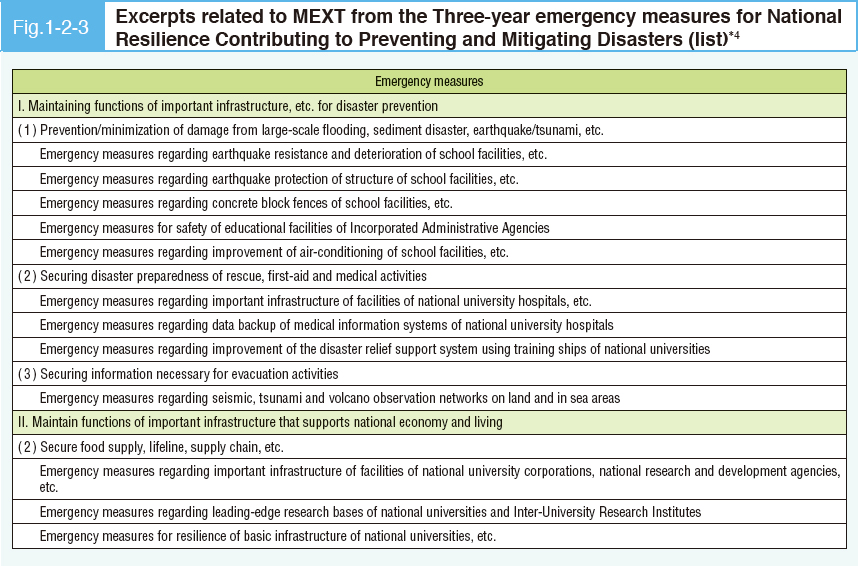
Promotion of disaster prevention/mitigation measures in schools
Reorganization of MEXT for strengthening disaster protection functions
Earthquakes, heavy rain and other natural disasters have been more frequent, diverse and severer in recent years. Amid concerns of possible Tokyo Inland Earthquake, MEXT needs to promote disaster prevention/ mitigation measures based on the principle of national resilience and strengthen response to disasters.
For improvement of schools and other educational facilities, there is an increased need to strengthen safety and disaster prevention functions because these facilities are also used as shelter for local residents at the time of disasters.
In light of this situation, MEXT restructured its organization in order to strengthen disaster response in October 2018. The ministry established the “Disaster Prevention and Technical Affairs Division” as a director-level position primarily responsible for disaster prevention of educational facilities. With this change, the Department of Facilities Planning and Administration was reorganized to the Department of Facilities Planning and Disaster Prevention.
The reorganized department will promote disaster prevention measures of MEXT in an integrated manner.
The measures include: disaster prevention/mitigation measures for school facilities including earthquake resistance and securing of shelter functions; information gathering at the time of disaster; general coordination of measures in the ministry and; dispatch of liaisons to affected areas.
Earthquake-resistance measure of school facilities
Ensuring safety of school facilities through earthquake-resistance measures is crucially important because these facilities are places for daily learning and living for children and also serve as shelter of local residents at the time of disasters including earthquakes.
As a result of intensive support since the Great Hanshin-Awaji Earthquake, earthquake resistance of structures of national and public school facilities has been mostly completed with the exception of delays due to specific conditions. The earthquake resistance rate of private school facilities is about 90% in FY2018. We aim to complete their earthquake resistance as early as possible. We believe that it is a great result of the earthquake resistance works that there was no damage such as collapse in large earthquakes in recent years among school facilities for which earthquake resistance had been completed.
In the Great East Japan Earthquake in 2011, nonstructural members were heavily damaged. Examples include total collapse of gymnasium ceilings and lighting equipment of classrooms of public schools. In response, MEXT created the “Handbook for measures to prevent falling of ceilings, etc. of school facilities”*5 in August 2013 and carried out measures with focus on removal of suspended ceilings from gymnasiums, etc.
In the 2016 Kumamoto Earthquake, measures for suspended ceilings, etc. produced effects but breaking of roof braces*6, fall of ceiling materials, broken windowpanes and other damages made the gymnasiums unusable as shelter. This exposed problems in disaster prevention functions due to damages to nonstructural members. A survey of MEXT shows that the execution rate of earthquake-resistance measures for nonstructural members is lower than that for structures and suspended ceilings, which calls for further efforts.
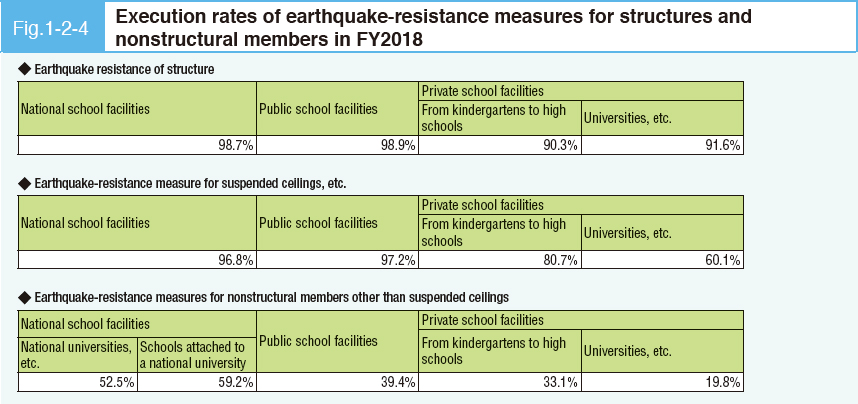
Earthquake-resistance measures for nonstructural members of school facilities are as important as earthquake resistance of structures in order to ensure safety of children and maintain their function as shelter of the community.
With the aim of promoting earthquake resistance inspection of nonstructural members, MEXT created the “Guidebook for Earthquake Protection for Nonstructural Members of School Facilities Revised Edition Protecting Children from Falling and Tumbling Objects due to an Earthquake – Implementing Earthquake Resistance Inspection –*7 (“the Guidebook”) in March 2015.
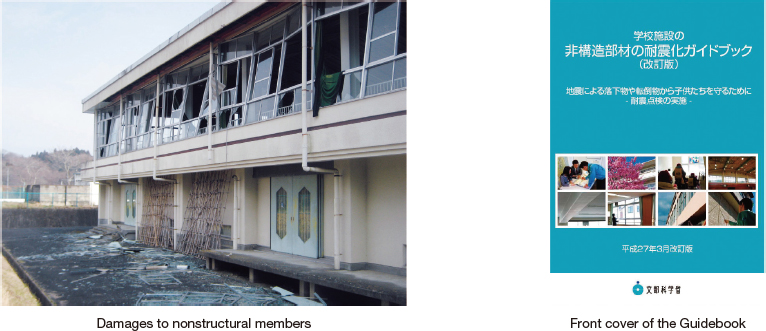
For earthquake-resistance measures of nonstructural members it is important to detect abnormalities at an early stage through earthquake resistance inspection to ensure safety at the time of earthquake. Earthquake resistance inspection needs to be implemented at the responsibility of the party that established the school who is the facility administrator. In order to ensure smooth inspection, it is important for the party who established the school to build a system for inspection in cooperation with teachers and other personnel, experts such as architects and related departments. The guidebook defines roles of parties that establish schools and schools and shows concrete inspection items and the direction of countermeasures for periodic and continuous inspection in preparation for earthquakes. There is a wide variety of nonstructural members. It is important to connect continuous inspection to preventive measures.
In response to the earthquake centered in the northern part of Osaka Prefecture mentioned above, MEXT compiled an expanded edition*8 of a guidebook introducing check points of concrete block fences, etc. based on the Building Standard Law Enforcement Order in March 2019 to ensure prompt implementation of safety inspection of concrete block fences, etc, and necessary improvements.
MEXT continues to provide necessary national subsidy to parties that establish schools who have not yet completed earthquake resistance of structures and earthquake-resistant measures of nonstructural members and asks them to promptly implement necessary measures.
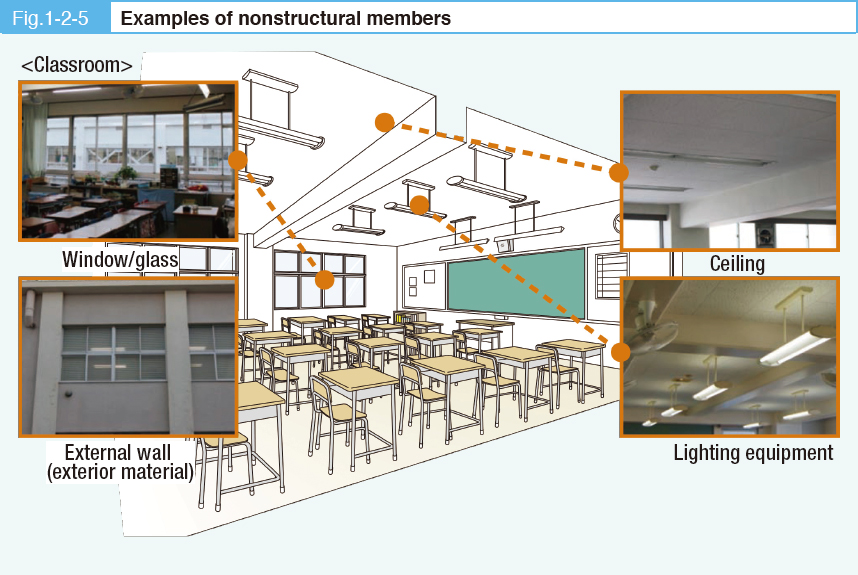
Maintenance of school facilities
■Maintenance is essential for the safety of children.
School facilities need to be safe and functional not only in everyday life but also at the time of disaster. However, the performances secured at the time of construction might decline due to aging and fail to fulfill the requirements. If they are left as they are without noticing the condition, there is a risk of accidents such as sudden fall of external wall tiles or mortar. It is necessary to carry out periodic inspections based on laws/regulations and promptly make necessary repair in order to always maintain sound conditions.
■Maintenance of school facilities is the responsibility of the party that establishes the school.
For appropriate maintenance of school facilities, the parties that establish the schools who own the facilities and manage the facilities and teachers and other personnel using the facilities need to carry out inspections, etc. in accordance with their position so that the state of the facilities compliant with the law is always maintained. MEXT is promoting appropriate maintenance of school facilities. For example, the ministry created “Protecting Childrenʼs Safety – Maintenance Handbook for Parties that Establish Schools –” in March 2016. The handbook explains the need for maintenance that parties that establish schools should implement based on the provisions of the Building Standards Act, etc. and outline of the system.
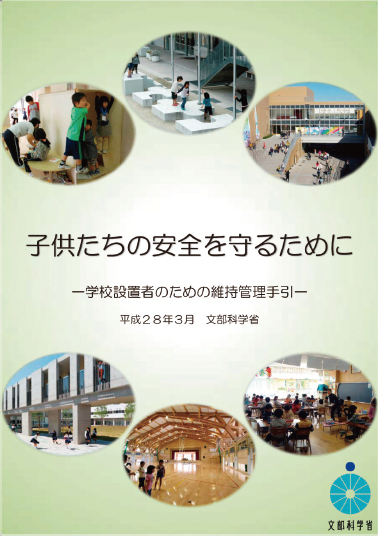
○“Protecting Children’s Safety – Maintenance Handbook for Parties that Establish Schools –” March 2016
※http://www.mext.go.jp/a_menu/shisetu/maintenance/__icsFiles/afieldfile/2017/06/14/1369016_01_1.pdf (PDF:668KB) ![]()
Strengthening disaster protection functions of school facilities
In the Great East Japan Earthquake in 2011, about 8,000 schools suffered various damages including submergence/flooding of school buildings and gymnasiums due to tsunami, as well as damage to the structure and fall of nonstructural members caused by the earthquake.
In the light of the situation, MEXT at the Committee for Research Studies on the Visions of School Facilities studied tsunami countermeasures for school facilities and their modalities to serve as shelter and compiled a report*9 in March 2014. Regarding tsunami protection measures, the report finds it important that, if the school premise has a risk of damage due to tsunami, the party that established the school should understand the location of the school and the situation of the surrounding area, consider and carry out safety measures (e.g. evacuation to a high place or a tsunami refuge building in the vicinity; evacuation to the rooftop or a upper floor of the school building, etc.; relocation to a high place) in close coordination with disaster prevention departments, etc. It is important to carry out these measures not only when constructing or rebuilding school facilities but also for existing facilities (see the Column for examples.)
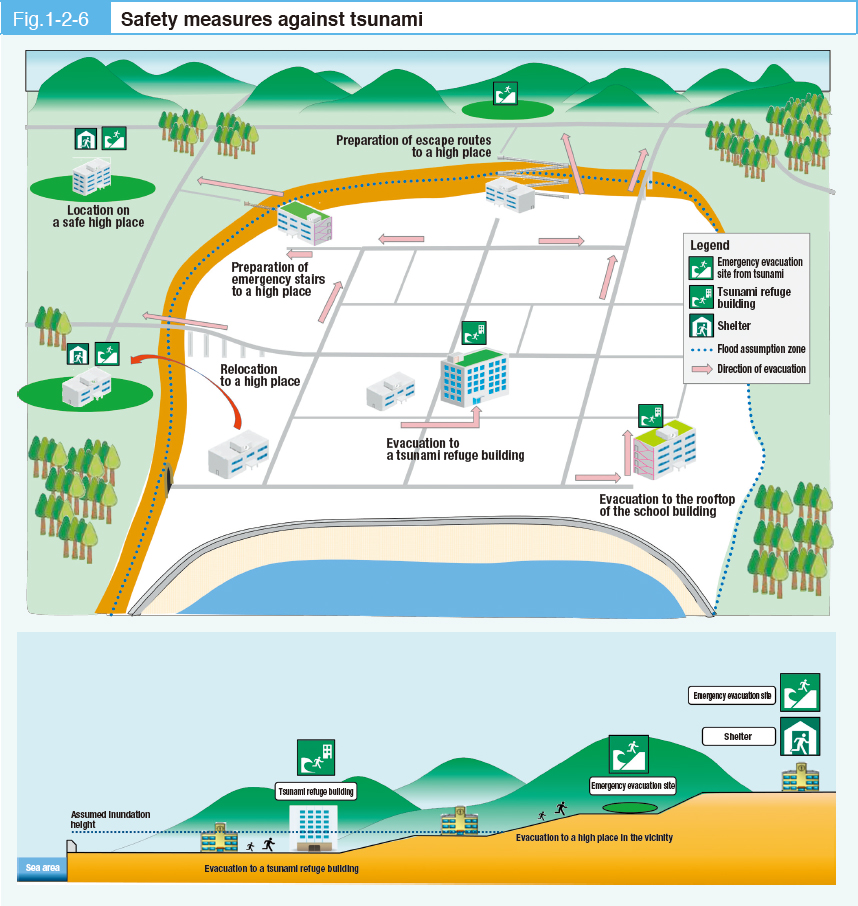
Regarding enhancement of disaster protection of shelters, the report divides the process from disaster occurrence to closure of shelters into four phases and organizes the functions necessary in each phase. Because the functions necessary for a shelter varies depending on the phase, it is important to consider measures with these phases in mind.
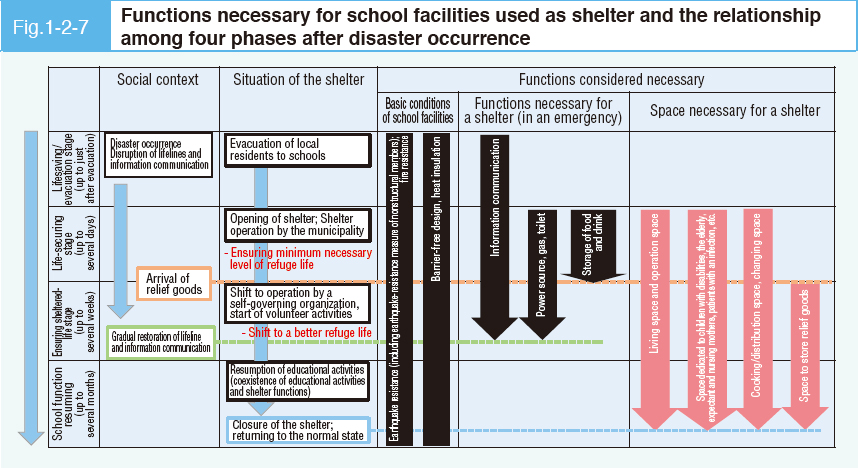
At the time of the 2016 Kumamoto Earthquake, we experienced various challenges concerning shelters. For example, gymnasiums could not be used due to damage to nonstructural members, and there are inconvenience for using the toilet, electricity and water. With the aim of grasping the state of disaster protection functions necessary for a shelter at the stage from evacuation of children, personnel, local residents, etc, to arrival relief goods (Life-securing stage (up to several days)) MEXT implemented the “Survey on disaster protection functions of public school facilities that will be used as shelter”*10 in FY2017. The survey shows that 30,994 public schools (about 90%) are designated as shelter. The survey revealed that only about half of the designated schools have disaster protection functions concerning toilets during water failure and regarding power supply. It is necessary to continue strengthening disaster protection functions.
In response, MEXT asked boards of education and others to further enhance disaster protection functions by efforts such as: disaster prevention departments lead construction of an appropriate system for cooperation with boards of education and local people involved; and define the role, functions and facility utilization plan for each school facility. The ministry also holds seminars on disaster protection countermeasures for school facilities to disseminate information on strengthening of disaster protection functions of school facilities.

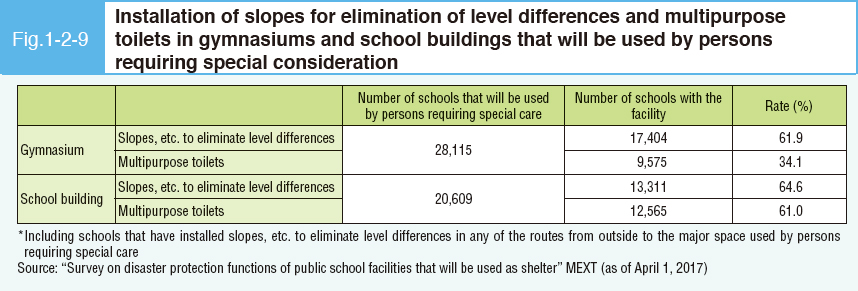
Furthermore, the ministry started survey research in FY2018 in order to compile a collection of examples regarding strengthening disaster protection functions of school facilities.
As a part of its supports for protection measures, strengthening disaster protection functions and other efforts that are made by parties that establish schools, MEXT provides national subsidies for earthquake-resistance measures, storehouses, outdoor toilets, generation facilities, hygienic and safe school lunch facilities for providing meals which can be used as a soup kitchen despite a poor general hygienic environment at the time of disaster, rebuilding including relocation of buildings that are in an area where flooding by tsunami, etc is expected, as well as installation of escape routes and outdoor escape stairs.
Examples of disaster prevention/mitigation measures of local governments and schools (e.g. improvement of school facilities to enhance disaster protection functions)
○ Strengthening disaster protection functions as shelter based on the past disaster experiences (Nagaoka city, Niigata)
Based on the experience of running shelters at the time of the Niigata Chuetsu arthquake in 2004, Nagaoka City, Niigata, has been improving facilities of its 85 municipal schools that will be used as shelters for the communities. The city will spend about 100 million yen for the period from FY2017 to FY2019 for the construction works for shelter functions, which include the following:
① Installation of slopes to gymnasiums because evacuees in wheelchairs had difficulty going in and out (permanent slopes to the extent possible, movable slopes if not possible)
② Replacement of Japanese-style toilets in gymnasiums with western-style toilets because some feeble elderly citizens became unwell by using Japanese-style toilets
③ Telephone wiring and television wiring in gymnasiums based on the experience of repeated coming and going between the gymnasium used as shelter and the school office in order to answer incessant telephone calls for safety confirmation
④ Installation of faucet to water receiving tanks so that people can use water during water failure
⑤ Installation of the connector sockets of converters from LP gas to city gas to gas pipes in order to use city gas stoves with LP gas until restoration of city gas
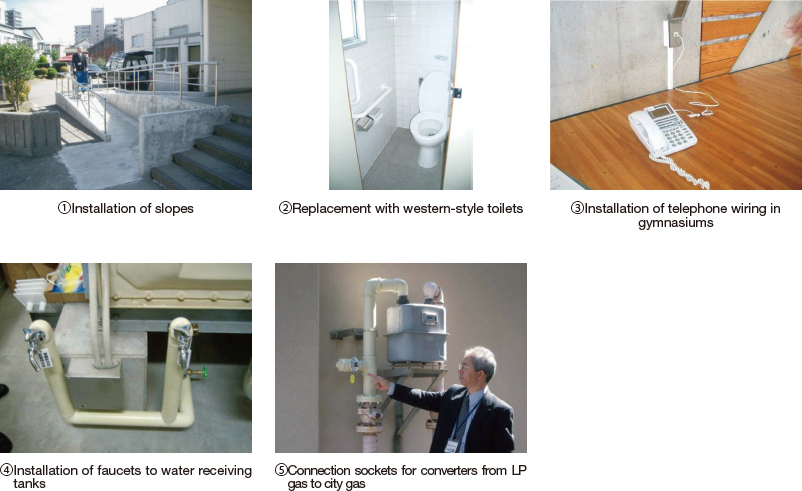
○ Strengthening disaster protection functions in preparation for earthquake and water damage (Edogawa Ward Komatsugawa Daini Junior-high School)
In low-lying Edogawa Ward, gymnasiums and emergency supply warehouses are built on the second floor of public elementary and junior-high schools at the time of rebuilding as a flood damage countermeasure. Functions to cope with power outage and water failure are also added.
The new school building of Edogawa Ward Konatsugawa Daini Junior-high School was completed in February 2018. It is built on a high-standard levee with the aim of enhancing its shelter function of the community at the time of disaster. Key items of the schoolʼs disaster protection measures are as follows:
① Emergency supplies storehouse is installed near the gymnasium where evacuees will live at the time of disaster to ensure easy access
② Installing piping to supply water of a rooftop swimming pool for flushing toilets in the school building during water failure
③ Five Manhole Toilets are installed in the schoolyard. The toilets can be used with water of the swimming pool during water failure.
④ Installing gas air-conditioners that heat, cool and generate power using gas during power outage in some classrooms. The power can be used for lighting.
⑤ Installing equipment for automatic switching to supply photovoltaic generation to emergency outlets in the gymnasium, staff room and emergency supplies storehouse in order to ensure power supply during power outage
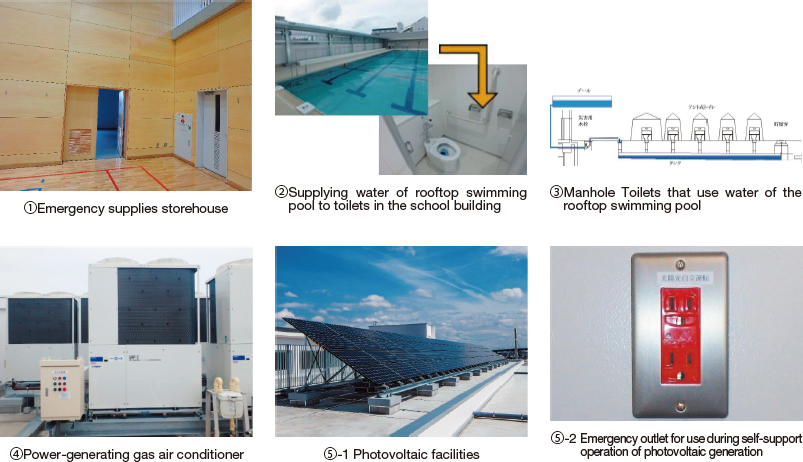
○ Ensuring safe evacuation to rooftop (Shimanto Municipal Takeshima Elementary School, Kochi Prefecture)
For Shimanto Municipal Takeshima Elementary School, 1- to 3-meter inundation is forecasted due to tsunami of the Nankai Trough Huge Earthquake. Assuming that a safe route or enough time to evacuate to an emergency evacuation site may not be available, the school installed outdoor escape stairs for vertical evacuation to the rooftop of the school building in 2012. Other major improvements are as follows:
① Installing Outdoor escape stairs on the southern side of the school building, for evacuation from adjacent Takeshima nursery school and Takeshima district. Riser of the stair is 16 cm, the same as the stairs in the school building.
② A door with a key is installed at the entrance of the outdoor emergency stairs for crime prevention, but the door is made of plaster board so that it can be kicked open for evacuation at the time of tsunami.
③ A door with a key is installed at the balcony of each floor of the school building for access to the outdoor emergency stairs so that children in the school building can escape directly to the stairs.
④ A slope is installed at the entrance from a general road at the southern side of the school building to the school premise in order to ensure wheelchair access by people requiring special care.

Promoting disaster prevention education at schools, etc.
In order to help children acquire an attitude to act independently to protect their own lives from dangers including natural disasters, each school provides consistent and systematic disaster prevention education in a planned manner by organizing teaching contents throughout the year and positioning them in its school safety plan according to the local characteristics and actual conditions of the children based on the National Curriculum Standards. The schools also implement practical disaster drills, etc. in preparation for natural disasters so that children can use the knowledge learned from individual subjects for their action.
MEXT revised its material for school safety: “Safety Education at Schools to Cultivate ‘Zest for Living’” based on the “Second Plan for Promotion of School Safety” and revision of the National Curriculum Standards. The revised “Safety Education” was distributed in March 2019 so that schools can used it as reference for safety education including disaster prevention education consistent with regional conditions
The ministry is promoting systematic initiatives for school safety and use of external experts by reference of Safety Promotion School*11 and other advanced cases. It also supports efforts of local governments to promote cooperation among national, public and private schools, and implementation of training sessions for school personnel who will serve as lecturers of disaster prevention classes.
In addition, MEXT is operating a school safety portal site carrying materials created by the ministry so that local governments can use information necessary for promotion of school safety and excellent initiative as reference.
In order to find solutions to global environmental issues that can be a cause of natural disasters, it is important that children deepen their understanding of environmental issues and learn to take responsible actions to protect the natural environment. To this end, MEXT improved the content of environmental education in the National Curriculum Standards for elementary, junior-high and high schools, which were revised in 2017 and 2018, while promoting and spreading good practices of environmental education.*12
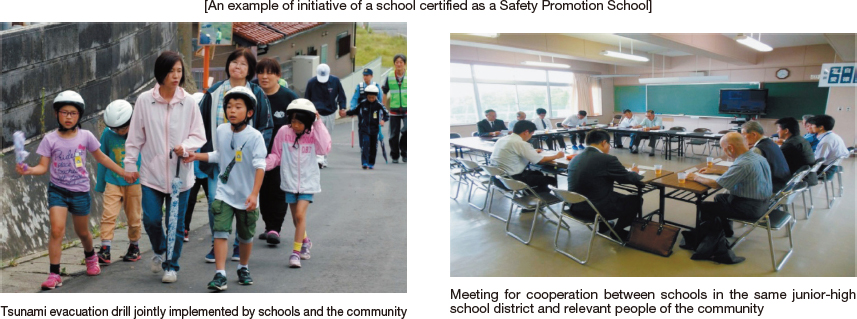
Disaster prevention for cultural properties
In order to protect precious cultural properties that should be surely handed down to posterity from typhoon, earthquake, fire and other damages, the Agency for Cultural Affairs is working to raise awareness of protection of cultural properties across Japan through the following initiatives, while at the same time promoting disaster prevention and mitigation measures including enhancement of earthquake protection of important cultural properties ((buildings and other structures). The agency is also supporting restoration of cultural properties damaged by frequent natural disasters in recent years.
(1) Dissemination and awareness raising for protection of cultural properties
The Act on Protection of Cultural Properties was enacted in response to the fire damage to Horyu-ji Kondo Wall Paintings that occurred in 1949.
With the aim of protecting cultural properties from fire, earthquake and other disasters and raising awareness for protection of cultural properties, January 26, that is the day when Horyu-ji Kondo Wall Paintings were damaged by fire, was made Bunkazai Boka Day (Cultural Property Fire Prevention Day). Centered around this day, the Agency for Cultural Affairs, the Fire and Disaster Management Agency, cultural property owners, local residents and others cooperate to conduct campaigns for fire protection of cultural properties.
On the 65th Bunkazai Boka Day in FY2018 a large-scale drill was conducted at Horyuji with attendance of the Commissioner of the Agency for Cultural Affairs and the Assistant Commissioner of the Fire and Disaster Management Agency.
(2) Earthquake resistance of important cultural properties (buildings and other structures)
We need to preserve cultural value of Important Cultural Properties (building structures) and the safety of people at the time of an earthquake. To this end, the Agency for Cultural Affairs is promoting systematic seismic evaluation (basic seismic evaluation and specialized seismic evaluation), implementation of earthquake resistance reinforcement and development and implementation of policies.
In order to further raise owners’ awareness of earthquake-resistant measures of Important Cultural Properties (buildings and other structures) and advance earthquake resistance enhancement, the agency developed the “Guideline for development of policy on earthquake protection of Important Cultural Properties (buildings and other structures)” and created a leaflet for its publicity.
(3) Recovery from the Great East Japan Earthquake and the Kumamoto Earthquake
The Agency is continuing its efforts to grasp the damage to cultural properties caused by the Great East Japan Earthquake, while at the same time dispatching Senior Cultural Properties Specialists upon request from affected areas. They provide guidance and advice on repair and restoration of damaged cultural properties. The Agency is also implementing the “Cultural Property Rescue Project” to rescue mobile cultural properties such as fine arts and crafts, take emergency measures for them and store them temporarily at museums and similar facilities. For immobile cultural properties, the “Cultural Properties Doctor Dispatch Project” investigates damage to them (buildings and other structure), takes emergency measures and provides technical supports for their restoration. As regards handling of buried cultural properties during restoration/reconstruction projects, the agency approves flexible handling such as limitation of the scope of excavation and research.
In response to the Kumamoto Earthquake, the agency set up the Project Team for Restoration and Reconstruction of Cultural Properties Damaged by the Kumamoto Earthquake for early repair and restoration of damaged cultural properties. For the heavily damaged Kumamoto Castle, the agency set up the Office for Comprehensive Support for Restoration of Kumamoto Castle. The Commissioner of the Agency for Cultural Affairs sent a message to call for donations for restoration of damaged cultural properties. The agency also provides technical supports through the Cultural Property Rescue Project and Cultural Properties Doctor Dispatch Project and dispatches staff specialized in buried cultural properties from around the country to support excavation and research during restoration and reconstruction work.
Promotion of research and development on disaster prevention
Japan is under natural conditions prone to many natural disasters including earthquakes, tsunamis, storms, tornadoes, heavy rains and volcano eruption. Natural disasters are still largely unexplained and wreak heavy damage. It is important to conduct survey research for accurate understanding and prediction of natural disasters, while carrying out research and development for damage reduction and using the results for disaster prevention and mitigation.
Headquarters for Earthquake Research Promotion and longterm assessment
The Headquarters for Earthquake Research Promotion (“Earthquake Headquarters”) was established in response to the Great Hanshin-Awaji Earthquake. With the aim of promoting earthquake research, the Earthquake Headquarters carry out comprehensive evaluation of seismic activities by collecting results of seismic observations, surveys and investigations by relevant organs along with planning of comprehensive and basic measures, coordination of budgets of relevant administrative organs and other services.
The Earthquake Research Committee set up under the Earthquake Headquarters assesses the areas, size and probability of earthquakes that are anticipated in the future (earthquakes along major active fault zone and subduction zone earthquakes). The results are made public as the “Long-term evaluation” (Fig. 1-2-10). On February 26, 2019, the committee made public the “Long-term evaluation of subduction zone earthquakes around the Japan Trench”*13 that evaluates earthquakes in the offshore area from Tohoku to Kanto along the Japan Trench.
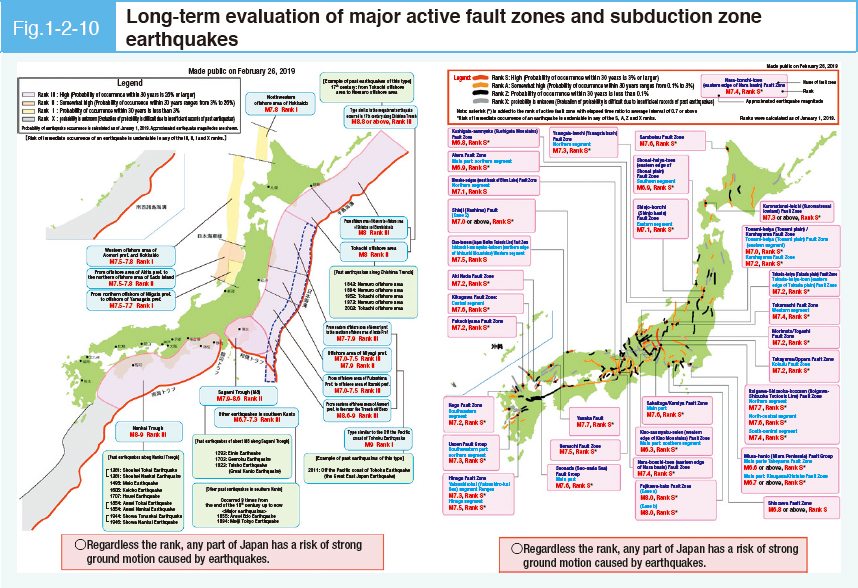
Construction and operation of observation network for earthquake, tsunami, etc.
MEXT is promoting research and development of earthquake/tsunami observation technologies and prediction methods. For example, at the National Research Institute for Earth Science and Disaster Resilience (NIED) is operating Monitoring of Waves on Land and Seafloor (MOWLAS), an integrated nationwide observation network for earthquakes, tsunamis, and volcanoes over land and sea, and is observing earthquakes, tsunamis, etc, occurring across the country in real-time.
Furthermore, in order to contribute to mitigation of the great damage expected from Nankai Trough earthquakes, MEXT is constructing a Nankai Trough Seafloor Observation Network for Earthquakes and Tsunamis (N-net) in the sea area from off the coast of Kochi Prefecture to Hyuga-nada, an area where an ocean bottom earthquake and tsunami observation network is not yet installed. Development of N-net will reduce the time to detect seismic motion and tsunami. In addition, when N-net is used for issuing tsunami warning, earthquake early warning, etc. in the future, it is expected to extend the time available for protecting human life against earthquake and tsunami.
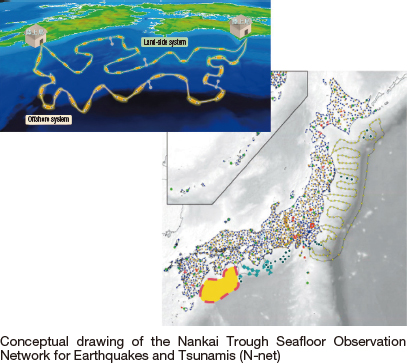
Efforts of National Research and Development Agency for disaster prevention/mitigation
Toward comprehensive improvement of (1) prediction and (2) prevention of, (3) response to and (4) restoration from a wide variety of natural disasters, NIED is conducting research and development on various natural disasters, which include: research on real-time prediction of earthquake ground motion, rapid detection and forecast of tsunamis using observation data of MOWLAS, development of the cross ministerial “Shared Information Platform for Disaster Management (SIP4D) and information sharing support using SIP4D.
Toward creation of a disaster-resistant society, the Japan Agency for Marine-Earth Science and Technology (JAMSTEC) is using the Deep-sea Scientific Drilling Vessel Chikyu, Research Vessel Kaimei and other means to develop systems for continuous and real-time observation of seafloor crustal deformation and monitor diverse fault motions in seismogenic zones.
Japan Aerospace Exploration Agency (JAXA) is enhancing response to catastrophic disasters through research and development of the “Disaster Relief Aircraft Information Sharing Network (D-NET )” that enables rapid and efficient integrated management of information of disaster and operation of rescue helicopters, etc. Its developed technologies have been used for rescue operations on disaster sites including the Heavy Rain in northern Kyushu in 2017. JAXA is also contributing to understanding of disaster conditions using satellite data*14.
MEXT will continue its research and development initiatives in order to provide outcomes that can be used effectively for disaster revention measures by the Central Disaster Management Council, relevant ministries and agencies, local governments, etc.
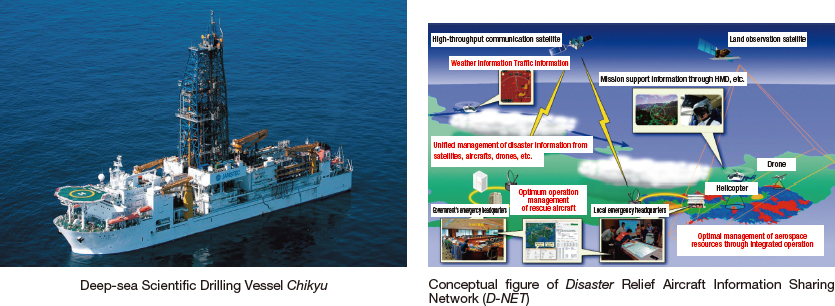
Disaster response of the National Research Institute for Earth Science and Disaster Resilience (NIED)
NIED comprehensively conducts basic research and fundamental R&D of science and technologies for prevention of damages caused by natural hazards, prevention of damage extension if a disaster should occur and restoration and reconstruction from the disaster. The aim is to improve the standard of science and technology for disaster resilience. Based on the 4th Mid-to Long-Term Goals starting from FY2016, NIED is actively promoting the following three activities for effective supports for disaster response, recovery and reconstruction:
① Providing information including observation and analysis results of the Monitoring of Waves on Land and Seafloor (MOWLAS) and weather radars of NIED, and results of on-site disaster investigation to the Headquarters for Earthquake Research Promotion, Coordinating Committee for Prediction of Volcanic Eruption and other state organs
② Setting up NIED Crisis Response Site (NIED-CRS) to gather information related to disaster and transmit information in sequence
③ Supporting information sharing of local emergency response headquarters by using the cross ministerial “Shared Information Platform for Disaster Management (SIP4D)
For example, before the disaster of the Heavy Rain in July 2018 that caused great damage in western Japan last year, NIED posted information of past typhoons with similar tracks on its website and called attention to possible disasters. In order to support disaster response, NIED set up NIEDCRS that gathers information on rainfall distribution, typhoon tracks and flooding/sediment disaster risks and results of heavy rain analysis, while dispatching NIED staff to local emergency response headquarters. In order to support information sharing using SIP4D, NIED gathered government and private information at the disaster response sites and provided the information to affected local governments and relevant ministries and agencies. The information helped activities at disaster sites.
NIED in cooperation with the central and local governments, companies, universities and various groups will continue to enhance R&D and information dissemination capabilities and promote standardization of operations with a goal of overcoming national disasters including a Nankai Trough earthquake, of which occurrence is feared.
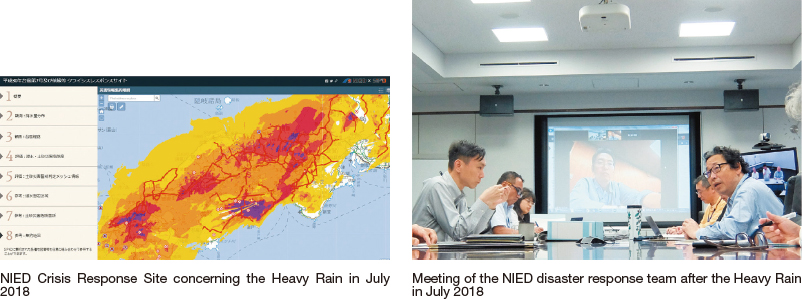
*1 Severe disaster: disasters that influence the national economy and cause particular need for mitigation of burden on local government finance and special subsidy to their victims.
*2 Reference: https://www.mext.go.jp/a_menu/shisetu/bousai/1408653.htm
*3 Reference: Part 2 Chapter 2
*4 Reference: https://www.kantei.go.jp/jp/singi/jyuyouinfura/sankanen/siryou4.pdf![]()
*5 Reference: https://www.mext.go.jp/a_menu/shisetu/bousai/taishin/1341100.htm
*6 Diagonal members for reinforcement
*7 Reference: https://www.mext.go.jp/a_menu/shisetu/shuppan/1291462.htm
*8 Reference: https://www.mext.go.jp/a_menu/shisetu/shuppan/1291462.htm
*9 Reference: https://www.mext.go.jp/b_menu/shingi/chousa/shisetu/013/toushin/1344800.htm
*10 Source: https://www.mext.go.jp/a_menu/shisetu/bousai/1394437.htm
*11 Safety promotion school: an initiative where Osaka Kyoiku University certifies schools that continuously practice initiatives for safety promotion (e.g. schools in cooperation with people interested in school safety in the community, related organizations, etc, assess their school safety plans and reflect the assessment in the plan of the following year based on a PDCA cycle).
*12 Reference: Part 2 Chapter 3 Section 2 9
*13 Reference: https://www.jishin.go.jp/evaluation/long_term_evaluation/subduction_fault/![]()
*14 Reference: Part 2 Chapter 7 Section 3-4
お問合せ先
Education Policy Bureau Policy Division